An Analysis of Disciplinary and Grievance Procedures in Organizations
VerifiedAdded on 2022/12/14
|7
|1775
|265
Report
AI Summary
This report provides a detailed overview of disciplinary and grievance procedures within the workplace, outlining the steps involved in managing employee performance and addressing complaints. It covers key aspects such as disciplinary processes, grievance procedures, and handling redundancy situations, emphasizing the importance of fair practices and adherence to employment laws. The report also examines fair and unfair dismissal scenarios, and the role of employment tribunals in resolving conflicts. The report emphasizes the importance of clear communication, thorough investigation, and a structured approach to ensure a positive work environment and maintain healthy employee relations, citing various resources such as books and journals to support the discussion.
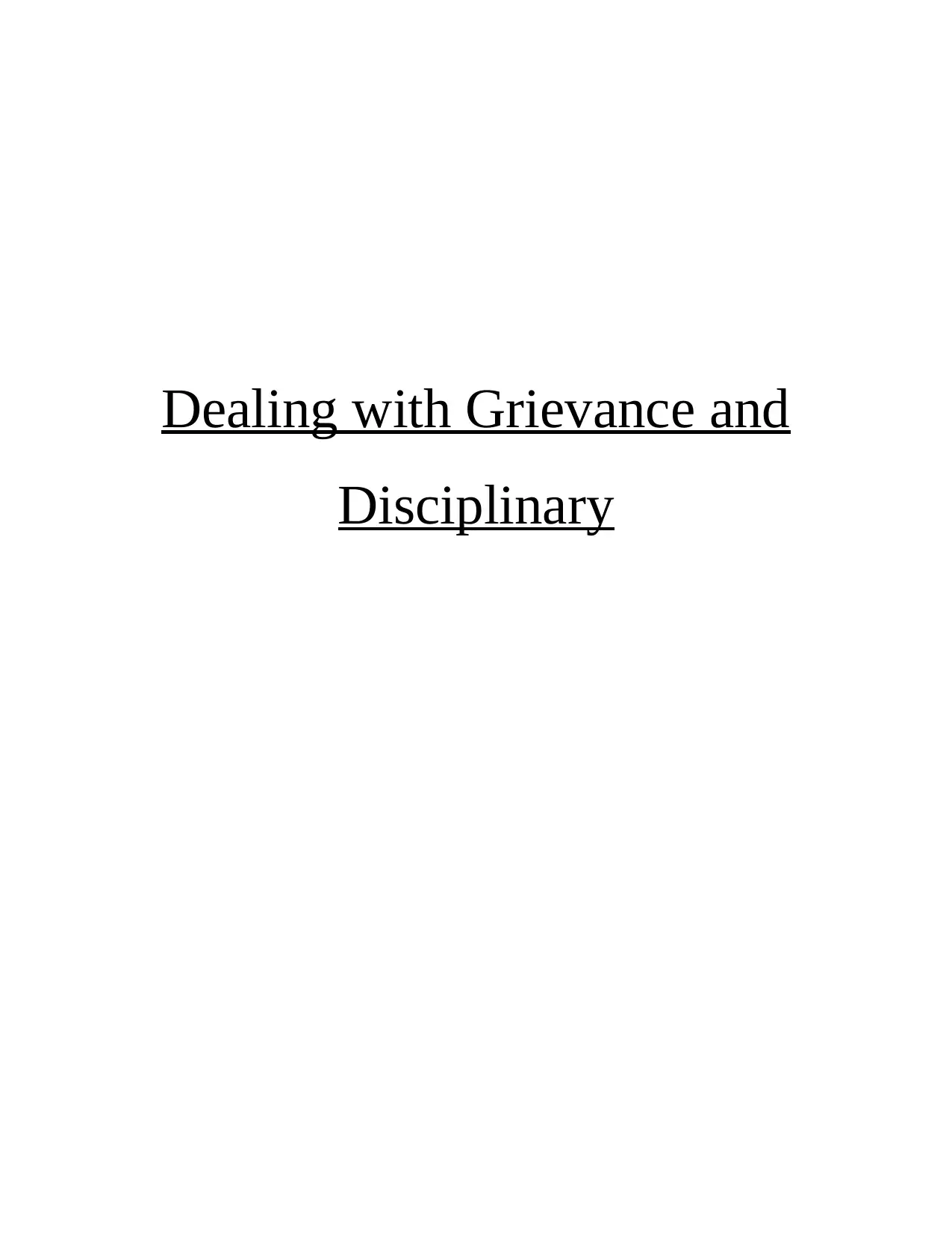
Dealing with Grievance and
Disciplinary
Disciplinary
Paraphrase This Document
Need a fresh take? Get an instant paraphrase of this document with our AI Paraphraser
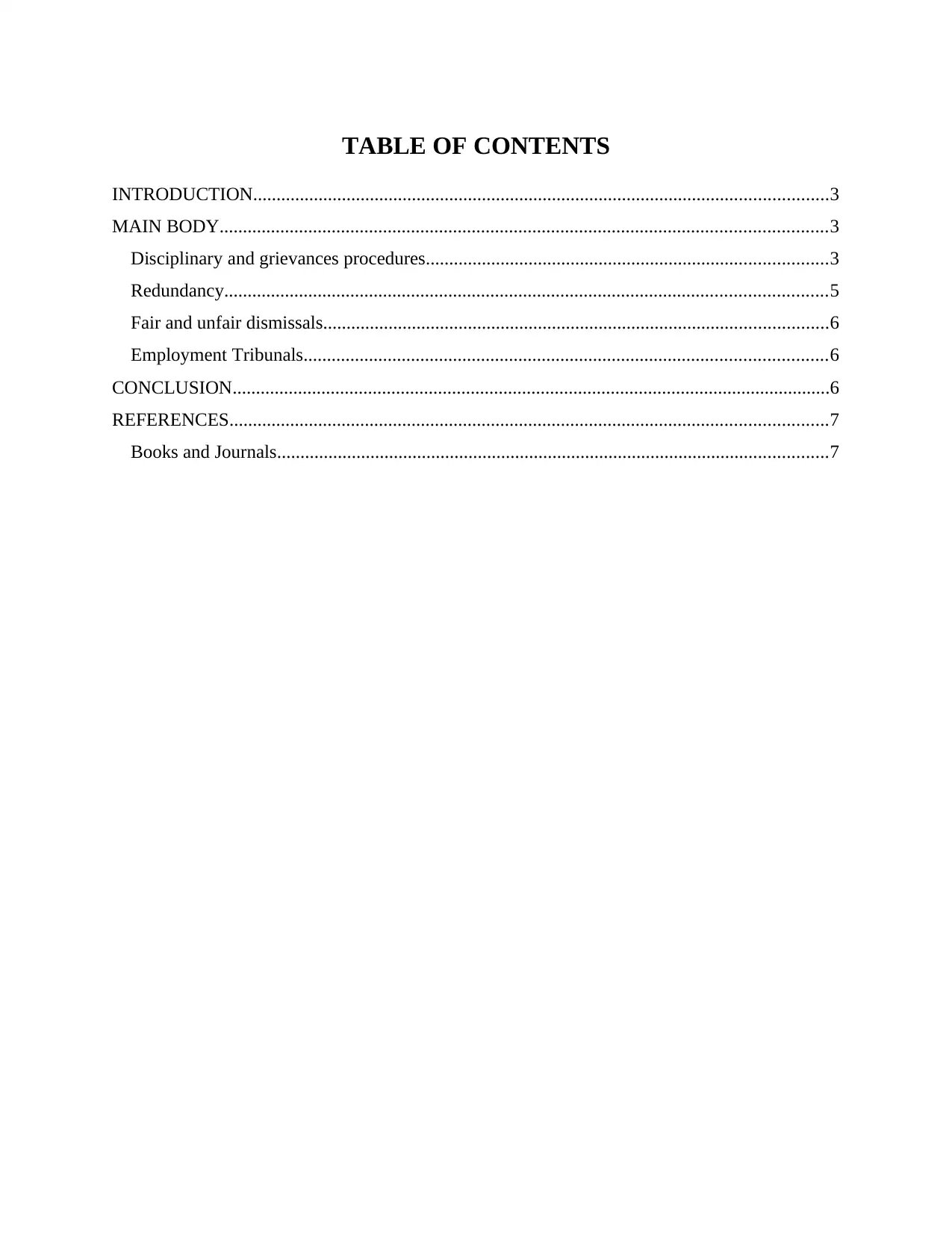
TABLE OF CONTENTS
INTRODUCTION...........................................................................................................................3
MAIN BODY..................................................................................................................................3
Disciplinary and grievances procedures......................................................................................3
Redundancy.................................................................................................................................5
Fair and unfair dismissals............................................................................................................6
Employment Tribunals................................................................................................................6
CONCLUSION................................................................................................................................6
REFERENCES................................................................................................................................7
Books and Journals......................................................................................................................7
INTRODUCTION...........................................................................................................................3
MAIN BODY..................................................................................................................................3
Disciplinary and grievances procedures......................................................................................3
Redundancy.................................................................................................................................5
Fair and unfair dismissals............................................................................................................6
Employment Tribunals................................................................................................................6
CONCLUSION................................................................................................................................6
REFERENCES................................................................................................................................7
Books and Journals......................................................................................................................7
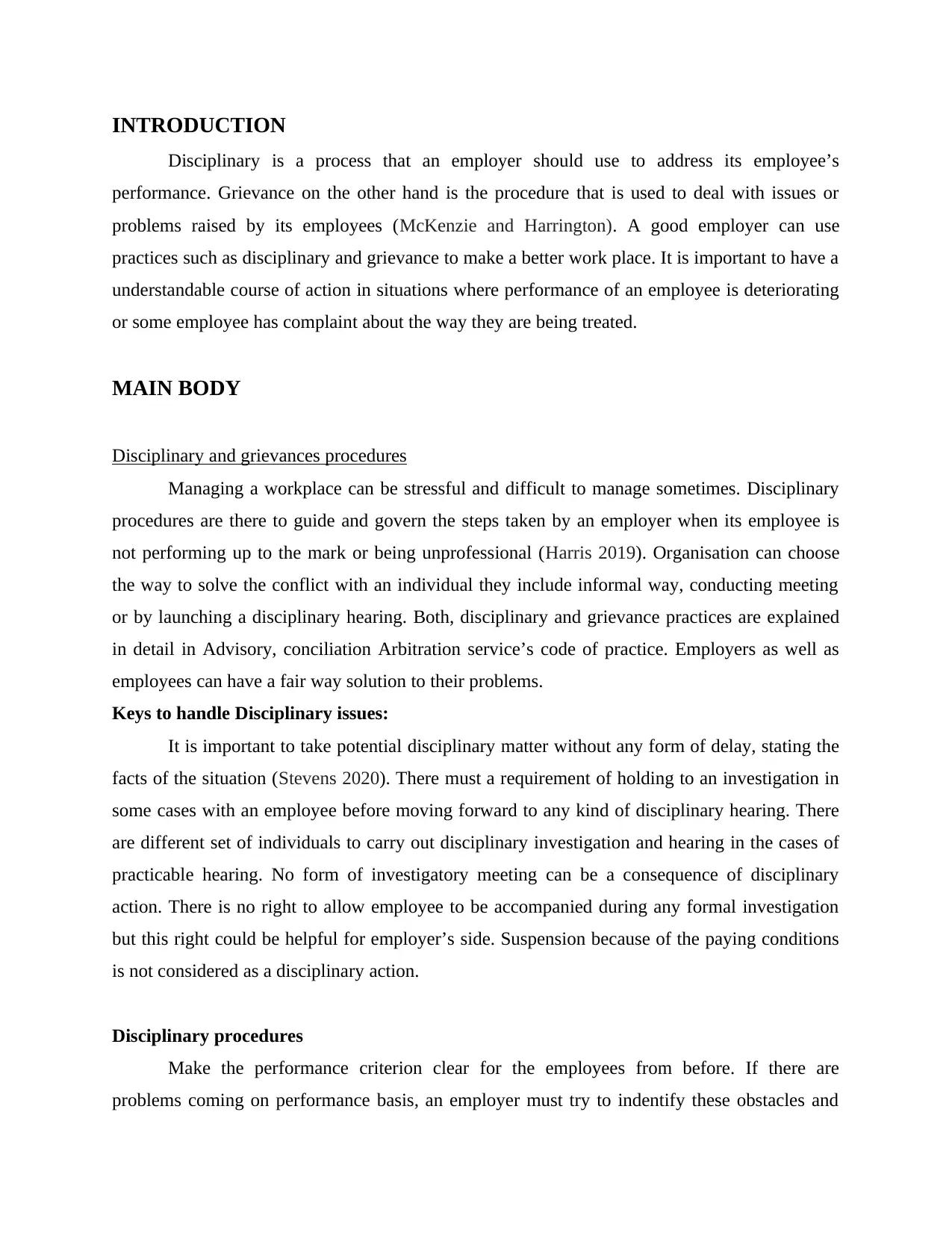
INTRODUCTION
Disciplinary is a process that an employer should use to address its employee’s
performance. Grievance on the other hand is the procedure that is used to deal with issues or
problems raised by its employees (McKenzie and Harrington). A good employer can use
practices such as disciplinary and grievance to make a better work place. It is important to have a
understandable course of action in situations where performance of an employee is deteriorating
or some employee has complaint about the way they are being treated.
MAIN BODY
Disciplinary and grievances procedures
Managing a workplace can be stressful and difficult to manage sometimes. Disciplinary
procedures are there to guide and govern the steps taken by an employer when its employee is
not performing up to the mark or being unprofessional (Harris 2019). Organisation can choose
the way to solve the conflict with an individual they include informal way, conducting meeting
or by launching a disciplinary hearing. Both, disciplinary and grievance practices are explained
in detail in Advisory, conciliation Arbitration service’s code of practice. Employers as well as
employees can have a fair way solution to their problems.
Keys to handle Disciplinary issues:
It is important to take potential disciplinary matter without any form of delay, stating the
facts of the situation (Stevens 2020). There must a requirement of holding to an investigation in
some cases with an employee before moving forward to any kind of disciplinary hearing. There
are different set of individuals to carry out disciplinary investigation and hearing in the cases of
practicable hearing. No form of investigatory meeting can be a consequence of disciplinary
action. There is no right to allow employee to be accompanied during any formal investigation
but this right could be helpful for employer’s side. Suspension because of the paying conditions
is not considered as a disciplinary action.
Disciplinary procedures
Make the performance criterion clear for the employees from before. If there are
problems coming on performance basis, an employer must try to indentify these obstacles and
Disciplinary is a process that an employer should use to address its employee’s
performance. Grievance on the other hand is the procedure that is used to deal with issues or
problems raised by its employees (McKenzie and Harrington). A good employer can use
practices such as disciplinary and grievance to make a better work place. It is important to have a
understandable course of action in situations where performance of an employee is deteriorating
or some employee has complaint about the way they are being treated.
MAIN BODY
Disciplinary and grievances procedures
Managing a workplace can be stressful and difficult to manage sometimes. Disciplinary
procedures are there to guide and govern the steps taken by an employer when its employee is
not performing up to the mark or being unprofessional (Harris 2019). Organisation can choose
the way to solve the conflict with an individual they include informal way, conducting meeting
or by launching a disciplinary hearing. Both, disciplinary and grievance practices are explained
in detail in Advisory, conciliation Arbitration service’s code of practice. Employers as well as
employees can have a fair way solution to their problems.
Keys to handle Disciplinary issues:
It is important to take potential disciplinary matter without any form of delay, stating the
facts of the situation (Stevens 2020). There must a requirement of holding to an investigation in
some cases with an employee before moving forward to any kind of disciplinary hearing. There
are different set of individuals to carry out disciplinary investigation and hearing in the cases of
practicable hearing. No form of investigatory meeting can be a consequence of disciplinary
action. There is no right to allow employee to be accompanied during any formal investigation
but this right could be helpful for employer’s side. Suspension because of the paying conditions
is not considered as a disciplinary action.
Disciplinary procedures
Make the performance criterion clear for the employees from before. If there are
problems coming on performance basis, an employer must try to indentify these obstacles and
⊘ This is a preview!⊘
Do you want full access?
Subscribe today to unlock all pages.

Trusted by 1+ million students worldwide
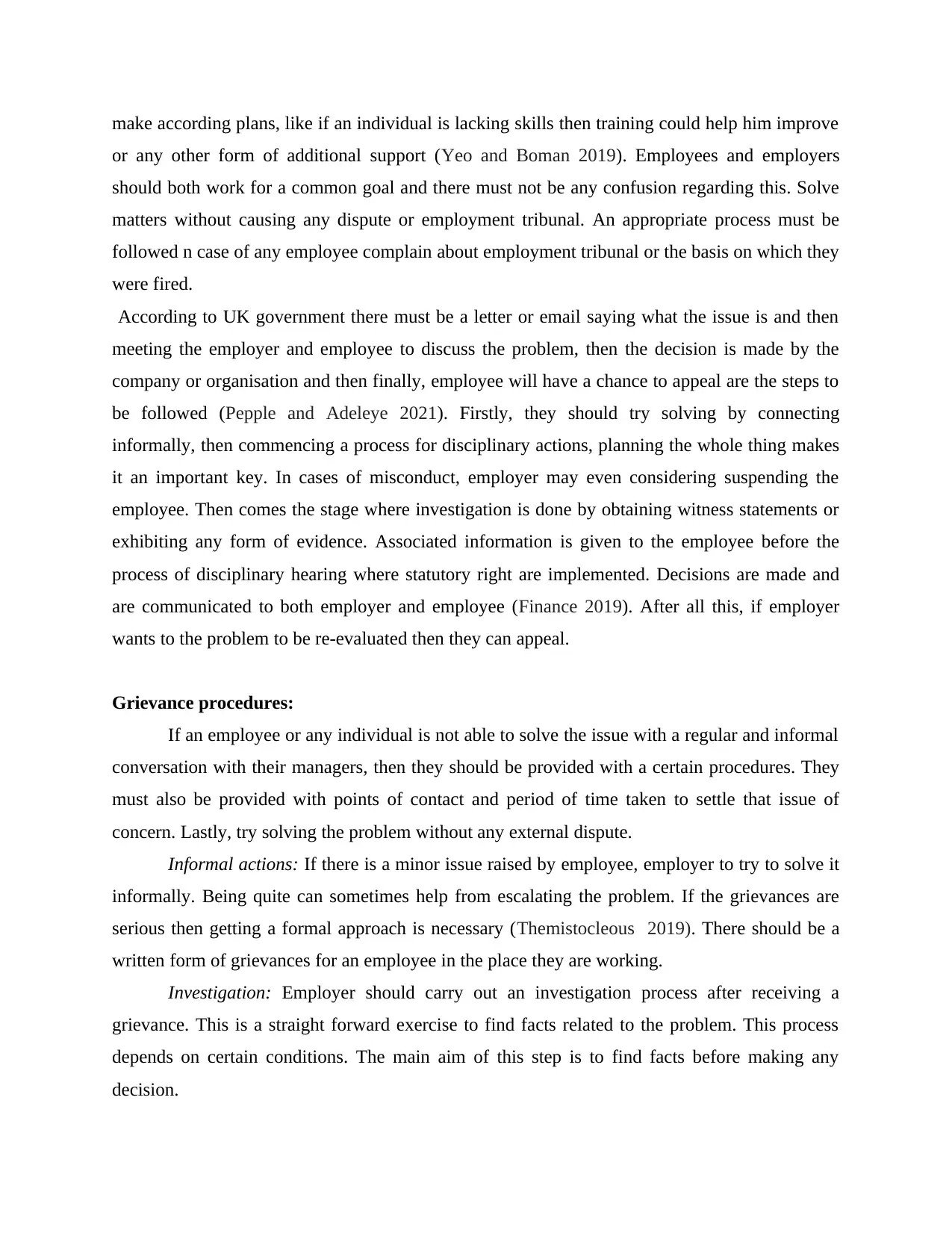
make according plans, like if an individual is lacking skills then training could help him improve
or any other form of additional support (Yeo and Boman 2019). Employees and employers
should both work for a common goal and there must not be any confusion regarding this. Solve
matters without causing any dispute or employment tribunal. An appropriate process must be
followed n case of any employee complain about employment tribunal or the basis on which they
were fired.
According to UK government there must be a letter or email saying what the issue is and then
meeting the employer and employee to discuss the problem, then the decision is made by the
company or organisation and then finally, employee will have a chance to appeal are the steps to
be followed (Pepple and Adeleye 2021). Firstly, they should try solving by connecting
informally, then commencing a process for disciplinary actions, planning the whole thing makes
it an important key. In cases of misconduct, employer may even considering suspending the
employee. Then comes the stage where investigation is done by obtaining witness statements or
exhibiting any form of evidence. Associated information is given to the employee before the
process of disciplinary hearing where statutory right are implemented. Decisions are made and
are communicated to both employer and employee (Finance 2019). After all this, if employer
wants to the problem to be re-evaluated then they can appeal.
Grievance procedures:
If an employee or any individual is not able to solve the issue with a regular and informal
conversation with their managers, then they should be provided with a certain procedures. They
must also be provided with points of contact and period of time taken to settle that issue of
concern. Lastly, try solving the problem without any external dispute.
Informal actions: If there is a minor issue raised by employee, employer to try to solve it
informally. Being quite can sometimes help from escalating the problem. If the grievances are
serious then getting a formal approach is necessary (Themistocleous 2019). There should be a
written form of grievances for an employee in the place they are working.
Investigation: Employer should carry out an investigation process after receiving a
grievance. This is a straight forward exercise to find facts related to the problem. This process
depends on certain conditions. The main aim of this step is to find facts before making any
decision.
or any other form of additional support (Yeo and Boman 2019). Employees and employers
should both work for a common goal and there must not be any confusion regarding this. Solve
matters without causing any dispute or employment tribunal. An appropriate process must be
followed n case of any employee complain about employment tribunal or the basis on which they
were fired.
According to UK government there must be a letter or email saying what the issue is and then
meeting the employer and employee to discuss the problem, then the decision is made by the
company or organisation and then finally, employee will have a chance to appeal are the steps to
be followed (Pepple and Adeleye 2021). Firstly, they should try solving by connecting
informally, then commencing a process for disciplinary actions, planning the whole thing makes
it an important key. In cases of misconduct, employer may even considering suspending the
employee. Then comes the stage where investigation is done by obtaining witness statements or
exhibiting any form of evidence. Associated information is given to the employee before the
process of disciplinary hearing where statutory right are implemented. Decisions are made and
are communicated to both employer and employee (Finance 2019). After all this, if employer
wants to the problem to be re-evaluated then they can appeal.
Grievance procedures:
If an employee or any individual is not able to solve the issue with a regular and informal
conversation with their managers, then they should be provided with a certain procedures. They
must also be provided with points of contact and period of time taken to settle that issue of
concern. Lastly, try solving the problem without any external dispute.
Informal actions: If there is a minor issue raised by employee, employer to try to solve it
informally. Being quite can sometimes help from escalating the problem. If the grievances are
serious then getting a formal approach is necessary (Themistocleous 2019). There should be a
written form of grievances for an employee in the place they are working.
Investigation: Employer should carry out an investigation process after receiving a
grievance. This is a straight forward exercise to find facts related to the problem. This process
depends on certain conditions. The main aim of this step is to find facts before making any
decision.
Paraphrase This Document
Need a fresh take? Get an instant paraphrase of this document with our AI Paraphraser
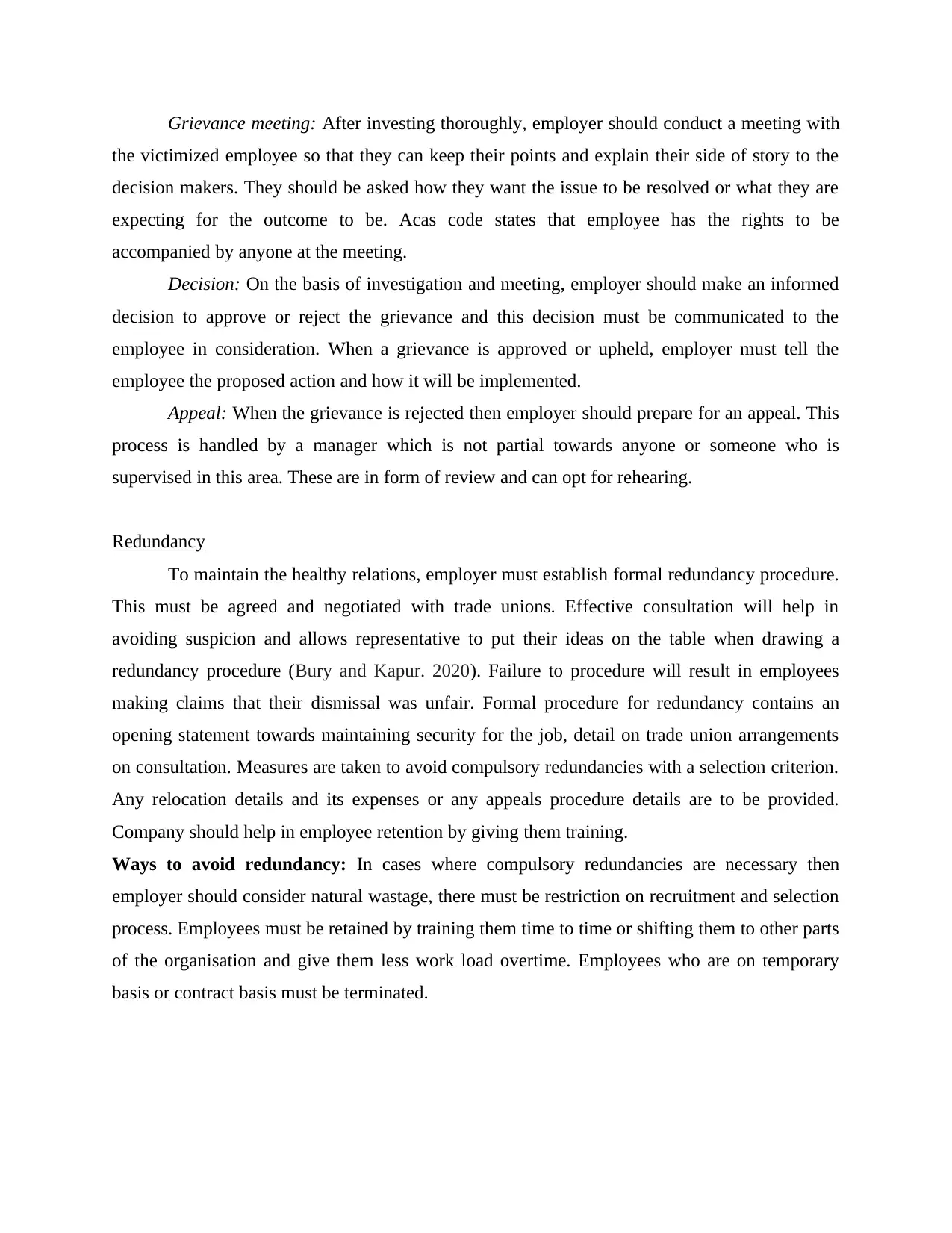
Grievance meeting: After investing thoroughly, employer should conduct a meeting with
the victimized employee so that they can keep their points and explain their side of story to the
decision makers. They should be asked how they want the issue to be resolved or what they are
expecting for the outcome to be. Acas code states that employee has the rights to be
accompanied by anyone at the meeting.
Decision: On the basis of investigation and meeting, employer should make an informed
decision to approve or reject the grievance and this decision must be communicated to the
employee in consideration. When a grievance is approved or upheld, employer must tell the
employee the proposed action and how it will be implemented.
Appeal: When the grievance is rejected then employer should prepare for an appeal. This
process is handled by a manager which is not partial towards anyone or someone who is
supervised in this area. These are in form of review and can opt for rehearing.
Redundancy
To maintain the healthy relations, employer must establish formal redundancy procedure.
This must be agreed and negotiated with trade unions. Effective consultation will help in
avoiding suspicion and allows representative to put their ideas on the table when drawing a
redundancy procedure (Bury and Kapur. 2020). Failure to procedure will result in employees
making claims that their dismissal was unfair. Formal procedure for redundancy contains an
opening statement towards maintaining security for the job, detail on trade union arrangements
on consultation. Measures are taken to avoid compulsory redundancies with a selection criterion.
Any relocation details and its expenses or any appeals procedure details are to be provided.
Company should help in employee retention by giving them training.
Ways to avoid redundancy: In cases where compulsory redundancies are necessary then
employer should consider natural wastage, there must be restriction on recruitment and selection
process. Employees must be retained by training them time to time or shifting them to other parts
of the organisation and give them less work load overtime. Employees who are on temporary
basis or contract basis must be terminated.
the victimized employee so that they can keep their points and explain their side of story to the
decision makers. They should be asked how they want the issue to be resolved or what they are
expecting for the outcome to be. Acas code states that employee has the rights to be
accompanied by anyone at the meeting.
Decision: On the basis of investigation and meeting, employer should make an informed
decision to approve or reject the grievance and this decision must be communicated to the
employee in consideration. When a grievance is approved or upheld, employer must tell the
employee the proposed action and how it will be implemented.
Appeal: When the grievance is rejected then employer should prepare for an appeal. This
process is handled by a manager which is not partial towards anyone or someone who is
supervised in this area. These are in form of review and can opt for rehearing.
Redundancy
To maintain the healthy relations, employer must establish formal redundancy procedure.
This must be agreed and negotiated with trade unions. Effective consultation will help in
avoiding suspicion and allows representative to put their ideas on the table when drawing a
redundancy procedure (Bury and Kapur. 2020). Failure to procedure will result in employees
making claims that their dismissal was unfair. Formal procedure for redundancy contains an
opening statement towards maintaining security for the job, detail on trade union arrangements
on consultation. Measures are taken to avoid compulsory redundancies with a selection criterion.
Any relocation details and its expenses or any appeals procedure details are to be provided.
Company should help in employee retention by giving them training.
Ways to avoid redundancy: In cases where compulsory redundancies are necessary then
employer should consider natural wastage, there must be restriction on recruitment and selection
process. Employees must be retained by training them time to time or shifting them to other parts
of the organisation and give them less work load overtime. Employees who are on temporary
basis or contract basis must be terminated.
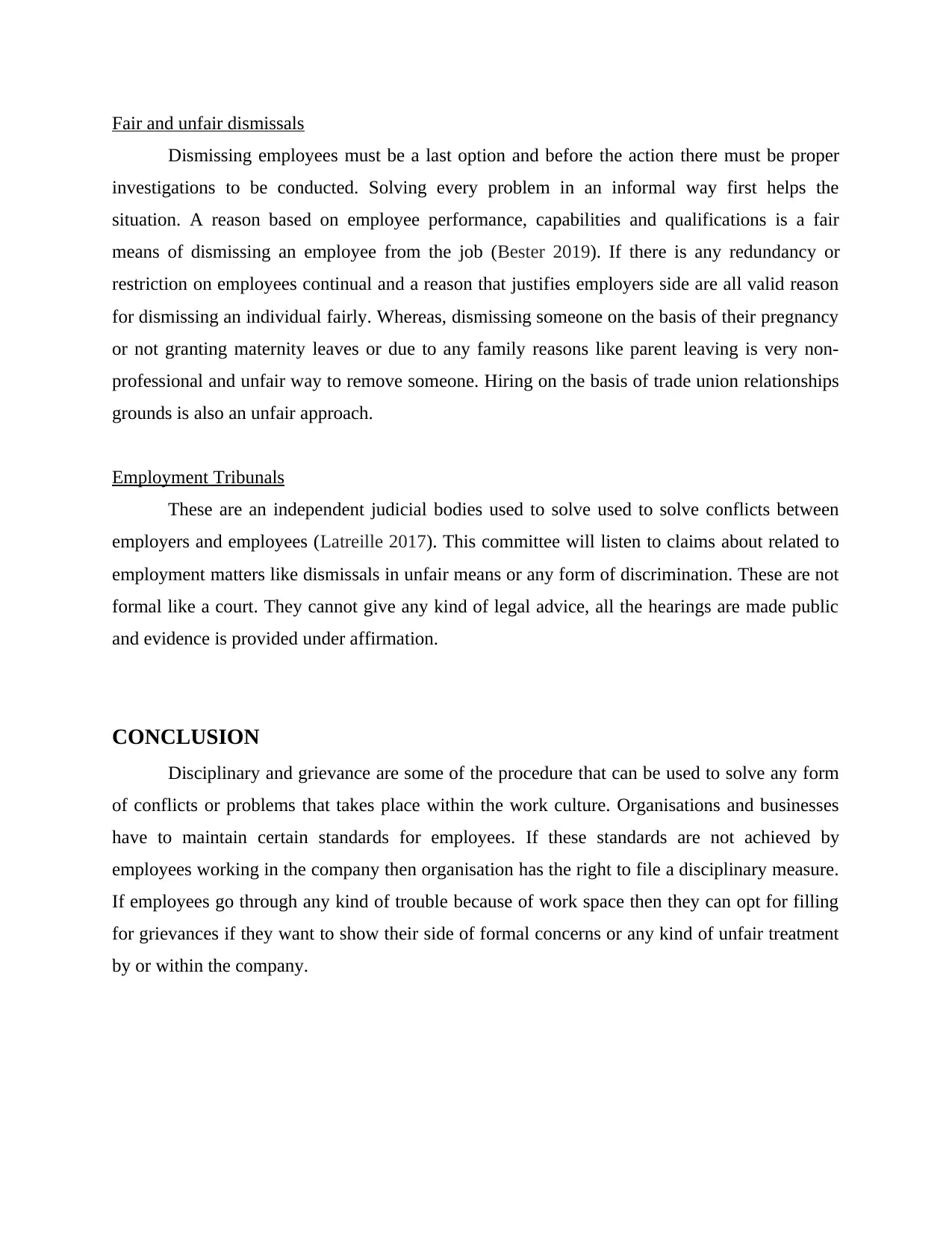
Fair and unfair dismissals
Dismissing employees must be a last option and before the action there must be proper
investigations to be conducted. Solving every problem in an informal way first helps the
situation. A reason based on employee performance, capabilities and qualifications is a fair
means of dismissing an employee from the job (Bester 2019). If there is any redundancy or
restriction on employees continual and a reason that justifies employers side are all valid reason
for dismissing an individual fairly. Whereas, dismissing someone on the basis of their pregnancy
or not granting maternity leaves or due to any family reasons like parent leaving is very non-
professional and unfair way to remove someone. Hiring on the basis of trade union relationships
grounds is also an unfair approach.
Employment Tribunals
These are an independent judicial bodies used to solve used to solve conflicts between
employers and employees (Latreille 2017). This committee will listen to claims about related to
employment matters like dismissals in unfair means or any form of discrimination. These are not
formal like a court. They cannot give any kind of legal advice, all the hearings are made public
and evidence is provided under affirmation.
CONCLUSION
Disciplinary and grievance are some of the procedure that can be used to solve any form
of conflicts or problems that takes place within the work culture. Organisations and businesses
have to maintain certain standards for employees. If these standards are not achieved by
employees working in the company then organisation has the right to file a disciplinary measure.
If employees go through any kind of trouble because of work space then they can opt for filling
for grievances if they want to show their side of formal concerns or any kind of unfair treatment
by or within the company.
Dismissing employees must be a last option and before the action there must be proper
investigations to be conducted. Solving every problem in an informal way first helps the
situation. A reason based on employee performance, capabilities and qualifications is a fair
means of dismissing an employee from the job (Bester 2019). If there is any redundancy or
restriction on employees continual and a reason that justifies employers side are all valid reason
for dismissing an individual fairly. Whereas, dismissing someone on the basis of their pregnancy
or not granting maternity leaves or due to any family reasons like parent leaving is very non-
professional and unfair way to remove someone. Hiring on the basis of trade union relationships
grounds is also an unfair approach.
Employment Tribunals
These are an independent judicial bodies used to solve used to solve conflicts between
employers and employees (Latreille 2017). This committee will listen to claims about related to
employment matters like dismissals in unfair means or any form of discrimination. These are not
formal like a court. They cannot give any kind of legal advice, all the hearings are made public
and evidence is provided under affirmation.
CONCLUSION
Disciplinary and grievance are some of the procedure that can be used to solve any form
of conflicts or problems that takes place within the work culture. Organisations and businesses
have to maintain certain standards for employees. If these standards are not achieved by
employees working in the company then organisation has the right to file a disciplinary measure.
If employees go through any kind of trouble because of work space then they can opt for filling
for grievances if they want to show their side of formal concerns or any kind of unfair treatment
by or within the company.
⊘ This is a preview!⊘
Do you want full access?
Subscribe today to unlock all pages.

Trusted by 1+ million students worldwide
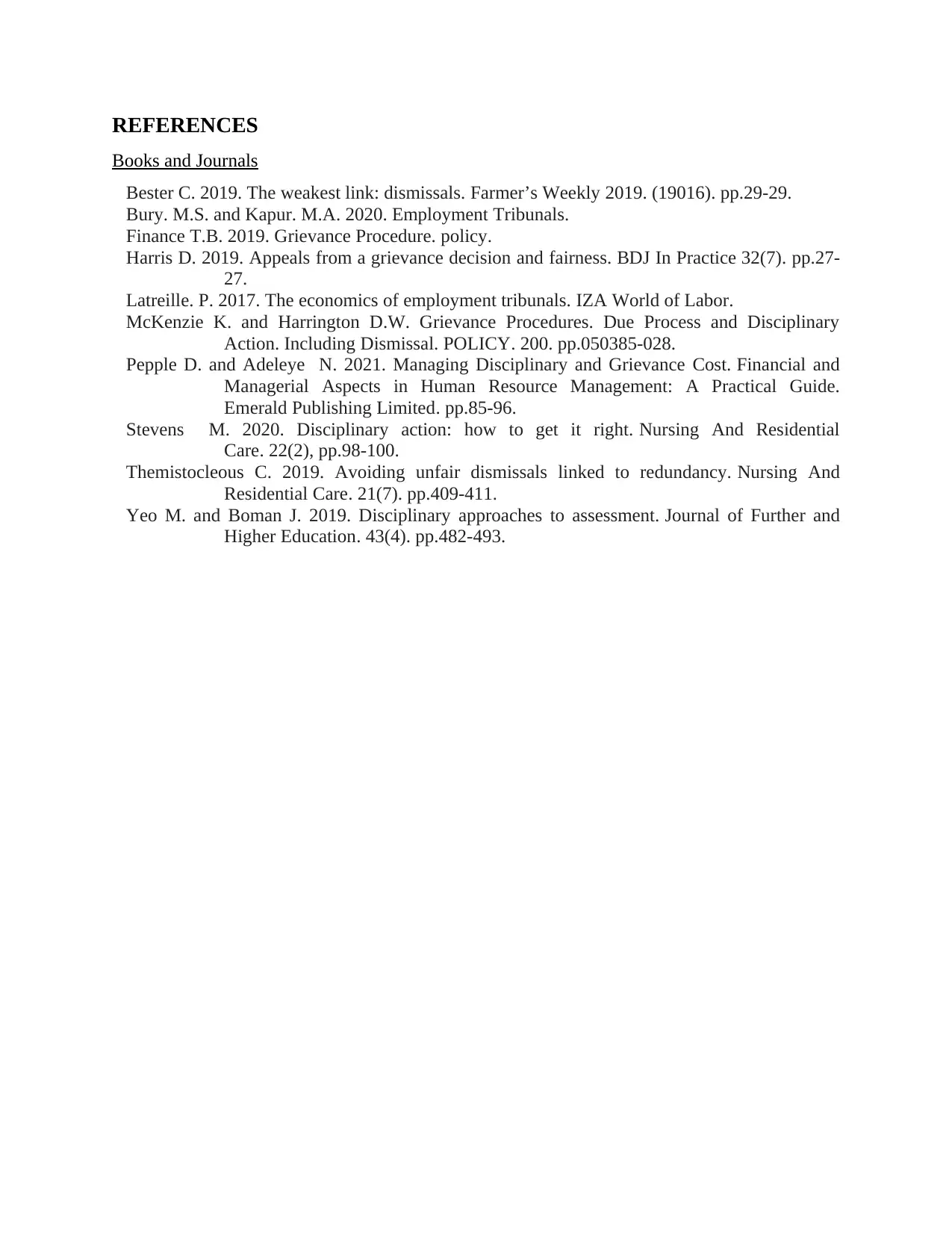
REFERENCES
Books and Journals
Bester C. 2019. The weakest link: dismissals. Farmer’s Weekly 2019. (19016). pp.29-29.
Bury. M.S. and Kapur. M.A. 2020. Employment Tribunals.
Finance T.B. 2019. Grievance Procedure. policy.
Harris D. 2019. Appeals from a grievance decision and fairness. BDJ In Practice 32(7). pp.27-
27.
Latreille. P. 2017. The economics of employment tribunals. IZA World of Labor.
McKenzie K. and Harrington D.W. Grievance Procedures. Due Process and Disciplinary
Action. Including Dismissal. POLICY. 200. pp.050385-028.
Pepple D. and Adeleye N. 2021. Managing Disciplinary and Grievance Cost. Financial and
Managerial Aspects in Human Resource Management: A Practical Guide.
Emerald Publishing Limited. pp.85-96.
Stevens M. 2020. Disciplinary action: how to get it right. Nursing And Residential
Care. 22(2), pp.98-100.
Themistocleous C. 2019. Avoiding unfair dismissals linked to redundancy. Nursing And
Residential Care. 21(7). pp.409-411.
Yeo M. and Boman J. 2019. Disciplinary approaches to assessment. Journal of Further and
Higher Education. 43(4). pp.482-493.
Books and Journals
Bester C. 2019. The weakest link: dismissals. Farmer’s Weekly 2019. (19016). pp.29-29.
Bury. M.S. and Kapur. M.A. 2020. Employment Tribunals.
Finance T.B. 2019. Grievance Procedure. policy.
Harris D. 2019. Appeals from a grievance decision and fairness. BDJ In Practice 32(7). pp.27-
27.
Latreille. P. 2017. The economics of employment tribunals. IZA World of Labor.
McKenzie K. and Harrington D.W. Grievance Procedures. Due Process and Disciplinary
Action. Including Dismissal. POLICY. 200. pp.050385-028.
Pepple D. and Adeleye N. 2021. Managing Disciplinary and Grievance Cost. Financial and
Managerial Aspects in Human Resource Management: A Practical Guide.
Emerald Publishing Limited. pp.85-96.
Stevens M. 2020. Disciplinary action: how to get it right. Nursing And Residential
Care. 22(2), pp.98-100.
Themistocleous C. 2019. Avoiding unfair dismissals linked to redundancy. Nursing And
Residential Care. 21(7). pp.409-411.
Yeo M. and Boman J. 2019. Disciplinary approaches to assessment. Journal of Further and
Higher Education. 43(4). pp.482-493.
1 out of 7
Related Documents
Your All-in-One AI-Powered Toolkit for Academic Success.
+13062052269
info@desklib.com
Available 24*7 on WhatsApp / Email
![[object Object]](/_next/static/media/star-bottom.7253800d.svg)
Unlock your academic potential
Copyright © 2020–2025 A2Z Services. All Rights Reserved. Developed and managed by ZUCOL.




